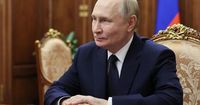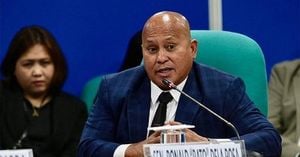Russian lawmakers have passed sweeping reforms to the country’s military draft system, turning what was once a biannual ritual into a year-round process—a move that signals Moscow’s resolve to keep its ranks filled as the war in Ukraine drags on into its fourth year. The lower house of parliament, the State Duma, approved the new law in its third and final reading on October 28, 2025, with the reform set to take effect in 2026 after the expected sign-off from the upper house and President Vladimir Putin.
The overhaul marks a major shift from the traditional spring and fall conscription seasons that have defined Russian military life for generations. According to Interfax and The Moscow Times, procedures such as medical exams, psychological tests, and draft board meetings will now take place continuously from January through December. This means that conscription offices will be able to summon potential draftees for assessments or administrative steps at any time of the year, not just in the previously set windows.
Yet the actual dispatch of new conscripts to military units will remain tied to the familiar cycles: between April and mid-July, and again from October to December, as dictated by presidential decree. This nuance, stressed by Defense Committee Chairman Andrei Kartapolov, is meant to reassure families and young men that a summons is just an invitation to report to the enlistment office—not an immediate ticket to the front. “People will receive summonses throughout the year,” Kartapolov explained, adding that the new system will allow military registration offices to spread their workload more evenly and avoid the chaos of previous years. “The law will help these offices run normally and smoothly year-round.”
The reform was backed by 405 lawmakers in its final reading, and its architects—Kartapolov and his deputy Andrei Krasov—argue that it will “streamline draft logistics” and “improve the quality” of recruitment. They described the seasonal operation of military offices as functioning in “scalded cat mode,” a nod to the frantic rush that used to grip the system during peak periods. By making draft board sessions and other administrative tasks a constant process, the government hopes to ease the pressure on staff and avoid administrative bottlenecks.
But not everyone is convinced that these changes are purely about efficiency. Rights groups and independent observers warn that the reform effectively institutionalizes permanent mobilization. As reported by The Moscow Times, critics fear that the new law gives authorities legal grounds for continuous raids, summons deliveries, and pressure on potential draftees throughout the year. “It’s a move toward a permanent mobilization system,” said one rights advocate, who noted that the reform could allow for more aggressive enforcement of draft compliance.
The law also tightens rules for those summoned via Russia’s digital draft registry, a system introduced earlier in 2025 to serve online summonses in some regions. Now, anyone receiving a digital summons will have 30 days to report to enlistment offices. Those who lose their deferments must appear within two weeks of the next call-up period. The law grants draft boards the power to issue deferments or exemptions remotely, without the conscript’s presence—a significant administrative change. Applications for alternative civilian service face stricter deadlines and must be submitted months ahead of deployment.
All Russian men aged 18-30 remain obliged to serve one year in the military, though many seek to avoid the draft through deferments granted for reasons such as student status or chronic illness. Despite these avenues, the military has called up between 130,000 and 160,000 draftees during each round of conscription, according to Interfax and other Russian news outlets. The changes introduced by the new law apply only to active conscripts, not to those currently in the reserves.
Russian authorities have repeatedly insisted that draftees are not used in Ukraine, relying instead on volunteers and reservists who were mobilized for action. However, human rights activists and media reports have indicated that the military has sought to encourage or even coerce many draftees into signing contracts as volunteers. Russia’s army, which numbered 1 million when Putin launched the full-scale invasion of Ukraine in February 2022, has steadily grown as the war has continued. Last year, Putin ordered the number of active troops to be increased by 180,000, bringing the total to 1.5 million. In September 2025, Putin claimed that more than 700,000 Russian troops were fighting in Ukraine.
The Kremlin has introduced a series of legal restrictions to combat draft evasion, including bans on bank transactions, suspensions of driver’s licenses, and prohibitions on foreign travel for those who ignore military summonses. The partial mobilization of 300,000 reservists in the fall of 2022, ordered by Putin, sparked widespread public backlash and led hundreds of thousands of Russians to flee abroad to avoid being called up. Since then, the Kremlin has shifted focus to boosting its forces with volunteers, offering relatively high wages and other benefits. Authorities reported that about 440,000 volunteers joined the military in 2024, with another 336,000 signing contracts in 2025.
Still, lawmakers are not relying solely on volunteers. On October 28, 2025, they passed another bill allowing reservists who have voluntarily signed contracts to be used for protecting “critically important facilities” in certain regions—a move its authors say is meant to bolster defenses against Ukrainian drone attacks that have reached more than 1,000 kilometers deep inside Russia. This measure will not apply to all reservists, only those in the active reserve by contract.
The Kremlin’s efforts to increase its ranks come as Putin resists international pressure for a ceasefire and maintains maximalist demands in the conflict with Ukraine. According to Axios, Ukrainian President Volodymyr Zelenskyy stated in 2025 that Russian military losses nearly equal the number of troops mobilized that year, underscoring the immense human cost of the ongoing war.
As the new draft law moves toward becoming the law of the land, its impact on Russian society—and on the war itself—remains to be seen. For now, it marks a decisive step toward a more permanent, institutionalized mobilization system, one that will touch the lives of millions of young Russian men and their families for years to come.






